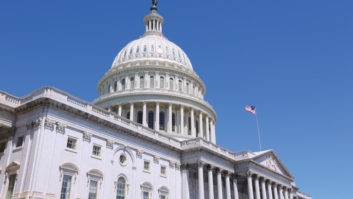
Legendary broadcast engineer Dick Burden has died. He passed on Saturday, peacefully in his sleep, according to a post on the Facebook page of the Los Angeles chapter 47 of the Society of Broadcast Engineers.
He was 92.
“It is not often in life that you meet someone who loves his family, friends and profession like Richard Burden,” the chapter post reads. “He gave 200% to everything he did with a smile on his face and love in his heart. We are all better people having known him.”

Richard W. Burden, born in 1931, played an influential role in several facets of broadcast engineering in the mid to late 20th century, including FM stereo, TV/radio audio engineering and the creation of the Traveler’s Information Service.
Yet decades into the 21st century, he remained a visible presence at trade shows and an active supporter of organizations like the L.A. SBE chapter.
According to the website of his firm Burden Associates, Burden originated the concept of initiating a control carrier as a means of switching from FM mono to FM stereo when stereophonic programming was present and adding an indicator that became known as the stereo light.
He was called the father of the Traveler’s Information Service for his work on the original TIS facility at the Los Angeles International Airport and the establishment of 530 and 1610 kHz as the original TIS operating frequencies.
In television he suggested a means to improve signal-to-noise performance to the proposed Stereophonic Television standard while maintaining authorized occupied bandwidth and de facto monophonic deviation, according to the website.
Burden became SBE member No. 450 in 1966 and was an original member of SBE Chapter 1 in Binghamton, N.Y., according to a 2005 profile article in Broadcast Engineering.
He helped organize Chapter 47 in Los Angeles, serving as its second chairman and as program chairman from 1979–1981. Maria Laing, current vice chair of the chapter, told RW: “He was a kind man who was happy to share his knowledge and time with anyone who asked. He always showed up with a smile on his face and love in his heart. In honor of his memory I challenge everyone to do something nice for someone today and to make a donation to SBE in his honor.”
Early days
His career started as a student at Lafayette College in Easton, Pa., where he was appointed chief engineer of college radio station WJRH in 1950. He transferred to RCA Institutes to study Radio Broadcast Engineering and graduated in 1952, holding a 1st Class Radio-Telephone License.
In 1952, according to the profile article, he was appointed to the Signal School in Fort Monmouth, N.J., as a civilian instructor. “Dick was assigned to the Armed Forces Radio Service in New York as staff engineer and was released from active duty with citations as a staff sergeant in 1955,” the article stated.
“He was employed at General Precision Laboratory for five years doing circuit design of audio-video and pulse modules, technical writing for video systems and engineering on the Air Traffic Control System for the Federal Aviation Administration.”
In 1958, he worked on the development of a system of stereo broadcasting in conjunction with Multiplex Development Corp. and held a patent in that field.
In 1960 he formed Burden Associates in Mount Kisco, N.Y. and in 1972, opened an office in Canoga Park, Calif.
He also served on the Ad Hoc Committee for the Study of Television Sound (ACHSTS); as a member of the Broadcast Transmission Systems Committee (BTS) on the study of Stereophonic Sound of Television; and as a member of the National Radio Systems Committee (NRSC) working toward improvements in radio broadcasting in the early 1990s.
He was a former chair of the AES Los Angeles Section and former Western Region vice president of AES.
He was also a founding member and original chief engineer of the Audio Internet Reading Service of Los Angeles, which he served as president and chairman.
Engineering honors
Burden achieved the rank of Fellow in the Society of Broadcast Engineers and the Audio Engineer Society, and was a Life Member of the Society of Motion Picture and Television Engineers.
He was honored by the Audio Engineering Society in 1998 on its Golden Anniversary as one of 25 internationally known audio engineers who had made significant contributions to the art and science of audio during the preceding 50 years.
The Society of Broadcast Engineers honored him in 2005 with its Lifetime Achievement Award for what was then already 55 years of service.
A 1995 oral history interview with Richard Burden is available, conducted by Frederik Nebeker, IEEE History Center. He discussed his work at Fort Monmouth and at Armed Forces Radio and his interest in hi-fi recording and FM. He describes his work with Bill Halstead in creating and demonstrating a proposed FM system as members of the National Stereo Radio Committee as well as his work in television sound and the National Radio Systems Committee, and the work he and Halstead did at the Los Angeles airport and the FCC’s consequent request that Burden remain in California to provide the Commission with data on the system.
You can read that oral history here: https://ethw.org/Oral-History:Richard_Burden







